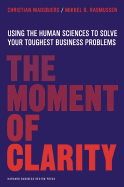Jack Covert Selects - Moment of Clarity
February 14, 2014
The Moment of Clarity: Using the Human Sciences to Solve Your Toughest Business Problems by Christian Madsbjerg and Mikkel B. Rasmussen, Harvard Business Review Press, 214 pages, $28. 00, Hardcover, February 2014, ISBN 9781422191903 Consider a time you were buying a gift for someone, and had to decide between two items.
The Moment of Clarity: Using the Human Sciences to Solve Your Toughest Business Problems by Christian Madsbjerg and Mikkel B. Rasmussen, Harvard Business Review Press, 214 pages, $28.00, Hardcover, February 2014, ISBN 9781422191903
Consider a time you were buying a gift for someone, and had to decide between two items. Likely the decision came down to which you guessed the recipient would appreciate more. Consider also a time you were lost, and the direction you took was based on intuition alone. These decisions were made using both human feeling and thinking, not data. If we were navigating them purely by data, little thinking would have to be done; the answers would have been obvious from the start.
Now apply this situation to your work. As much as we have moved toward a data-conscious workplace, human thought and feeling will always be a part of decision-making. So how do we more easily handle situations in which data is low and feeling and thinking are high? The Moment of Clarity: Using the Human Sciences to Solve Your Toughest Business Problems provides the answer.
Using theories and tools from the human sciences—anthropology, sociology, philosophy, and psychology—The Moment of Clarity reveals a problem-solving approach called “sensemaking” which can be used to set a company’s direction, drive growth, improve sales models, understand company culture, and more. The issue, according to Madsbjerg and Rasmussen, is that linear problem solving (“default thinking”) doesn’t include human behavior as an integral factor, even though it is a major piece of every puzzle. They explain:
Default thinking helps us create efficiencies, optimize resources, balance product portfolios, increase productivity, invest in markets with the shortest and biggest payback, cut operational complexity, and generally get more bang for the buck. In short, it works extraordinarily well when the business challenge demands an increase in the productivity of a system.
But what happens when the challenge involves people’s behavior? When it comes to cultural shifts, the use of a hypothesis based on past examples will give us a false sense of confidence, sending us astray into unknown waters with the wrong map. How many of your business issues involve people and their behavior? Likely, most of them do. This is an invaluable book for all managers and leaders to better understand “people holistically in their environments” and better handle the innate variability of the challenges that arise there. As the authors make clear, data is useful for system productivity, but we need a manual for human change. This is it.


